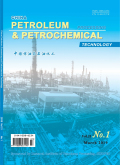- 钛学术文献服务平台 \
- 学术期刊 \
- 工业技术期刊 \
- 石油与天然气工业期刊 \
- 中国炼油与石油化工(英文版)期刊 \
High-efficiency Extraction of Bitumen from Oil Sands Using Mixture of Ionic Liquid [Emim][BF4] and Dichloromethane
High-efficiency Extraction of Bitumen from Oil Sands Using Mixture of Ionic Liquid [Emim][BF4] and Dichloromethane
基本信息来源于合作网站,原文需代理用户跳转至来源网站获取
摘要:
An ionic liquid (IL), 1-ethyl-3-methyl imidazolium tetrafluoroborate ([Emim][BF4]), was used to enhance bitumen recovery from oil sands by dichloromethane solvent extraction. A multiphase system could be formed by simply mixing the components at ambient temperature, consisting of sands and clays, mixtures of ionic liquid and dichloromethane, and concentrated bitumen layer. The results demonstrated that [Emim][BF4] increased the bitumen recovery up to 92%. Much less clay fines were found in the recovered bitumen than those formed by using dichloromethane solvent extraction alone, and the dichloromethane residue was not detected in the spent sands. We proposed that [Emim][BF4] had an ability to reduce the adhesion of bitumen to sand, resulting in an improved separation efficiency. Furthermore, [Emim][BF4] could facilitate the transfer of the extracted bitumen to the surface interface, and then the bitumen was auto-partitioned to a separate immiscible phase for ease of harvesting. This technology circumvented the issue of high consumption of distillation energy due to separation of bitumen phase and low boiling point of dichloromethane. [Emim][BF4] and dichloromethane could be readily recycled through the system and used repeatedly. After ten cycles, the bitumen recovery remained above 88%. Initial scale-up work suggested that this approach would form the basis for a viable large-scale process.

推荐文章
[NH2-emim]Br/[Bmim]BF4离子液体中二氧化碳的电化学还原
二氧化碳
离子液体
二元混合物
电化学
循环伏安
Oil geochemistry derived from the Qinjiatun–Qikeshu oilfields: insight from light hydrocarbons
Light hydrocarbons
Crude oil
Lishu Fault Depression
Geochemistry characteristic
[EMIM][BF4]离子液体电解质中nano-TiO2/Ti电催化还原CO2性能的研究
二氧化碳
电还原
离子液体
TiO2纳米管阵列
电催化
内容分析
关键词云
关键词热度
相关文献总数
(/次)
(/年)
文献信息
| 篇名 | High-efficiency Extraction of Bitumen from Oil Sands Using Mixture of Ionic Liquid [Emim][BF4] and Dichloromethane | ||
| 来源期刊 | 中国炼油与石油化工(英文版) | 学科 | |
| 关键词 | |||
| 年,卷(期) | 2021,(2) | 所属期刊栏目 | Process Research |
| 研究方向 | 页码范围 | 132-138 | |
| 页数 | 7页 | 分类号 | |
| 字数 | 语种 | 英文 | |
| DOI | |||
五维指标
引文网络
引文网络
二级参考文献 (116)
共引文献 (9)
参考文献 (19)
节点文献
引证文献 (0)
同被引文献 (0)
二级引证文献 (0)
1932(3)
- 参考文献(0)
- 二级参考文献(3)
1977(1)
- 参考文献(0)
- 二级参考文献(1)
1982(2)
- 参考文献(0)
- 二级参考文献(2)
1983(2)
- 参考文献(0)
- 二级参考文献(2)
1993(1)
- 参考文献(0)
- 二级参考文献(1)
1994(2)
- 参考文献(0)
- 二级参考文献(2)
1996(2)
- 参考文献(0)
- 二级参考文献(2)
1998(4)
- 参考文献(0)
- 二级参考文献(4)
1999(2)
- 参考文献(0)
- 二级参考文献(2)
2000(2)
- 参考文献(0)
- 二级参考文献(2)
2001(2)
- 参考文献(0)
- 二级参考文献(2)
2002(3)
- 参考文献(0)
- 二级参考文献(3)
2003(4)
- 参考文献(0)
- 二级参考文献(4)
2004(3)
- 参考文献(0)
- 二级参考文献(3)
2005(2)
- 参考文献(0)
- 二级参考文献(2)
2007(5)
- 参考文献(0)
- 二级参考文献(5)
2008(8)
- 参考文献(1)
- 二级参考文献(7)
2009(7)
- 参考文献(0)
- 二级参考文献(7)
2010(18)
- 参考文献(4)
- 二级参考文献(14)
2011(17)
- 参考文献(1)
- 二级参考文献(16)
2012(6)
- 参考文献(0)
- 二级参考文献(6)
2013(8)
- 参考文献(1)
- 二级参考文献(7)
2014(9)
- 参考文献(1)
- 二级参考文献(8)
2015(8)
- 参考文献(2)
- 二级参考文献(6)
2016(7)
- 参考文献(3)
- 二级参考文献(4)
2017(4)
- 参考文献(3)
- 二级参考文献(1)
2018(3)
- 参考文献(3)
- 二级参考文献(0)
2021(0)
- 参考文献(0)
- 二级参考文献(0)
- 引证文献(0)
- 二级引证文献(0)
引文网络交叉学科
相关学者/机构
期刊影响力
中国炼油与石油化工(英文版)
主办单位:
中国石化集团石油化工科学研究院
出版周期:
季刊
ISSN:
1008-6234
CN:
11-4012/TE
开本:
大16开
出版地:
北京海淀学院路18号
邮发代号:
创刊时间:
1999
语种:
eng
出版文献量(篇)
1608
总下载数(次)
0
总被引数(次)
1651
期刊文献
相关文献
推荐文献
- 期刊分类
- 期刊(年)
- 期刊(期)
- 期刊推荐
一般工业技术
交通运输
军事科技
冶金工业
动力工程
化学工业
原子能技术
大学学报
建筑科学
无线电电子学与电信技术
机械与仪表工业
水利工程
环境科学与安全科学
电工技术
石油与天然气工业
矿业工程
自动化技术与计算机技术
航空航天
轻工业与手工业
金属学与金属工艺
中国炼油与石油化工(英文版)2022
中国炼油与石油化工(英文版)2021
中国炼油与石油化工(英文版)2020
中国炼油与石油化工(英文版)2019
中国炼油与石油化工(英文版)2018
中国炼油与石油化工(英文版)2017
中国炼油与石油化工(英文版)2016
中国炼油与石油化工(英文版)2015
中国炼油与石油化工(英文版)2014
中国炼油与石油化工(英文版)2013
中国炼油与石油化工(英文版)2012
中国炼油与石油化工(英文版)2011
中国炼油与石油化工(英文版)2010
中国炼油与石油化工(英文版)2009
中国炼油与石油化工(英文版)2008
中国炼油与石油化工(英文版)2007
中国炼油与石油化工(英文版)2006
中国炼油与石油化工(英文版)2005
中国炼油与石油化工(英文版)2004
中国炼油与石油化工(英文版)2003
中国炼油与石油化工(英文版)2002
中国炼油与石油化工(英文版)2001
中国炼油与石油化工(英文版)2000

 免费查重
免费查重










